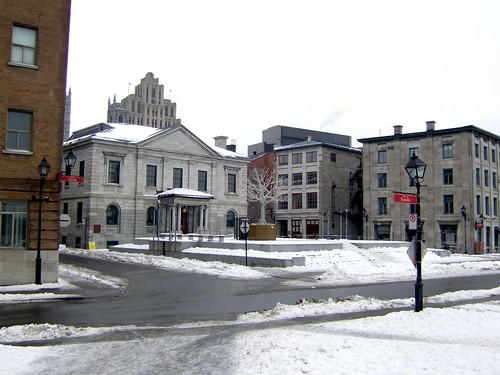When most people think of important public squares in Old Montréal, two spaces come to mind. Place d’Armes, the setting for the imposing Notre-Dame Basilica; and Place Jacques-Cartier, preferred tourist promenade and site of summer activities. Rarely does one think of Place Royale, a small and easy to miss square next to the Pointe-à-Callière museum. But in the 1700s when Montreal was not much more than a frontier town this unassuming little square was the centre of community life.
As the nascent settlement was being laid out by the Sulpicians in the late 1600s, they reserved a small plot of land along the river’s shore for use as a public market. True to this plan, every Tuesday and Friday it was market day in what was to aptly become known as Place du Marché. In the pre-industrial town this made the square the economic hub of Montreal, a status it would retain through the 1700s. Moreover, as the map below shows, it was around this square that the town developed the most densely built, “urban” character. It was also the location where public punishments were inflicted upon convicts, attesting to the fact that Montrealers of that era viewed it as the gathering spot of the community.
Montreal as it appeared in the late 1700s. The Place du Marché can be along the waterfront where the St-Pierre creek meets the St. Lawrence.
During this period of time Place d’Armes hosted the Notre-Dame Church (the less grand predecessor of the current basilica), making it the spiritual centre of the community, but wasn’t the true focal point of the town. And the area that would become Place Jacques-Cartier was little more than a collection of cottages and vegetable gardens on the far east end of town.
By the early 1800s Montreal was expanding and it had outgrown the old market square. In 1803 a fire in the east end of Old Montreal destroyed dozens of buildings, including the city jail and the original Jesuit Seminary. This newly freed-up space was used to create a new public market square, which would later take the name Place Jacques-Cartier. This location would remain the site of a public market up until the 1950’s when Old Montreal began to decline and public markets came to be seen as an anachronism.
Having lost its main attraction, the Place du Marché ceased to be one of the key social and economic spaces of the city, though a smaller market did continue to be held at the location. In 1836 the market was closed and a large part of the square was taken up to constuct the Old Customs House, which is now part of the Pointe-à-Callière museum. It was called Place du Vieux Marché until 1892, the 250th anniversary of Montreal’s foundation, when it was renamed Place Royale to honour the occasion.
Place Royale as is appears today.
While Place Royale continues to be an officially designated public square, it is now an unremarkable space, both physically and socially. Once bustling with activity and of great importance for the community, it’s now a rather dull place where the only action is the occasional group of tourists wandering around. Given its modern-day appearance Montrealers can be forgiven for not being aware of the square’s historical significance. It’s one of many examples throughout Montreal of how radically cities and the spaces within them can change.



6 comments
Place Royale was also the location for the “Groupe de la Place Royale,” a contemporary dance group. I think Edouard Locke trained with them back in the day.
They moved to Ottawa in the ’70s, I trained there for a couple summers in the ’80s.
So now, when I see or am at Place Royale, I think of Ottawa.
A lost public space (almost). Placed way above the street level, with almost nowhere to sit and no shade for warm days, Place Royale is a post-mod public space gone wrong. It only works a few days a year, when the historical market occurs in the fall. If this square was done correctly, it would be one of the more popular destinations in Old Mtl. Instead it is quite sleepy, a bit of a black hole in a pretty strategic part of the neighbourhood.
Place Royale is home to one of Montreal’s most intriguing and sublime public fountains.
It’ll probably ever be that vibrant now being so small, but the current design makes the space seem barren and too ceremonious to attract the casual passersby to stop and socialize.
It’s a space you want to go to, but it is just not comfortable and hence not a very good people watching spot, you feel almost as if you are not supposed to be sitting on the concrete ledge, and that everything is somehow happening elsewhere. There is some subtle art in the square but it doesn’t get appreciated because of the no lounge feeling.
It’s also a roof structure, it has limited possibilities because of it’s function.